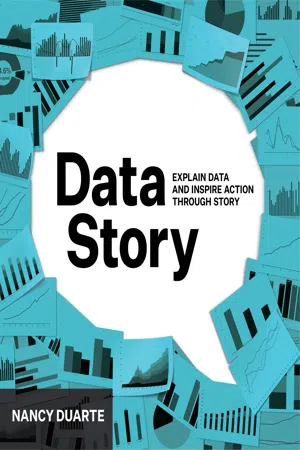
- English
- ePUB (mobile friendly)
- Available on iOS & Android
About this book
Scientists have proven that stories make the brain light up in ways no other form of communication does. Using story frameworks as a communication device for data will help make your recommendations stick and be acted on.
Organizations use data to identify problems or opportunities. The actions others may need to take today from your insights in data could reverse or improve the trajectory of your future data. So, communicating data well, drives very important outcomes.
Even though most roles depend on data, communicating well is the top skill gap in roles using data. The essential skill for today's leaders (and aspiring leaders) is shaping data into narratives that make a clear recommendation and inspire others to act.
Almost every role today uses data for decision making. As you grow in your career, you can become a strategic advisor and ultimately a leader using data to shape a future where humanity and organizations flourish.
Duarte and her team have culled through thousands of data slides of her clients in technology, finance, healthcare, and consumer products, to decode how the highest performing brands communicate with data.
DataStory teaches you the most effective ways to turn your data into narratives that blend the power of language, numbers, and graphics. This book is not about visualizing data, there are plenty of books covering that. Instead, you'll learn how to transform numbers into narratives to drive action.
- It will help you communicate data in a way that creates outcomes both inside and outside your own organization.
- It will help you earn a reputation as a trusted advisor, which will advance your career.
- it will help your organization make faster decisions and inspire others to act on them!
Nancy Duarte is one of the preeminent storytellers in American business and the acclaimed author of Slide: ology, Resonate, and the HBR Guide to Persuasive Presentations comes this book that will help you transform numbers into narratives.
Frequently asked questions
- Essential is ideal for learners and professionals who enjoy exploring a wide range of subjects. Access the Essential Library with 800,000+ trusted titles and best-sellers across business, personal growth, and the humanities. Includes unlimited reading time and Standard Read Aloud voice.
- Complete: Perfect for advanced learners and researchers needing full, unrestricted access. Unlock 1.4M+ books across hundreds of subjects, including academic and specialized titles. The Complete Plan also includes advanced features like Premium Read Aloud and Research Assistant.
Please note we cannot support devices running on iOS 13 and Android 7 or earlier. Learn more about using the app.
Information

Communicate Data to Others
CHAPTERS
I. Becoming a Communicator of Data
II. Communicating to Decision-Makers
I.
Becoming a Communicator of Data
Invest in Data Communication Skills
“Today, for anyone who wants a shot at a well-compensated position . . . comfort with data is increasingly essential.” 9Josh Bersin
Deloitte
Explain Data Through Storytelling

Become Like the Mentor in a Story
Table of contents
- Introduction
- SECTION 1 | Communicate Data to Others
- SECTION 2 | Bring Clarity Through Story Structure
- SECTION 3 | Make Clear Charts and Slides
- SECTION 4 | Make Data Stick
- Summary
- Appendix
- References